Are you wondering when to start introducing solid foods to your baby? This is a big step in your baby’s life. It’s important to do it right. Solid foods give your baby essential nutrients and help them develop good eating habits.
Our guide will help you through this journey. We’ll cover topics like introducing solid foods and starting solids for your baby.
As you start this new chapter, you’ll want to know when your baby is ready. Look for physical and developmental signs. You’ll also want to know the benefits of solid foods, like giving your baby important nutrients and teaching them to eat well.
Our goal is to give you a complete guide. We’ll cover introducing solid foods and starting solids for your baby.
Key Takeaways
- Introducing solid foods to your baby is a significant step towards providing essential nutrients and promoting healthy eating habits.
- Understanding the signs of readiness for solid foods is key for a smooth transition.
- Starting solids for baby needs patience, love, and a good plan.
- Introduce baby food gradually, starting with single-ingredient purees.
- A balanced diet is vital for your baby’s growth and development.
- Always talk to your pediatrician before introducing solid foods to your baby.
When Is Your Baby Ready for Solid Foods?
As a parent, you’re excited to introduce your baby to solid foods. But, it’s important to wait until they’re ready. The American Academy of Pediatrics suggests following infant feeding guidelines for a smooth start. Look for developmental signs, age, and physical readiness when deciding how to start solids.
Pediatricians say most babies are ready for solid foods between 4-6 months. They look for signs like good head and neck control, sitting up with support, and interest in food. Always talk to your pediatrician to find out the best time and discuss best first foods for baby.
Key Developmental Signs to Watch For
- Good head and neck control
- Ability to sit up with support
- Interest in food
- Loss of “tongue-thrust reflex”
Age Recommendations from Pediatricians
Pediatricians suggest starting solid foods at 6 months. But, some babies might be ready sooner or later. Always follow infant feeding guidelines and talk to your pediatrician for the best approach.
Physical Readiness Indicators
Look for signs like the ability to swallow and handle different textures. Following these guidelines and consulting with your pediatrician will help your baby start solid foods well. This ensures a great start in life for your baby.
Essential Equipment for Starting Solid Foods
When introducing purees to baby, having the right tools is key. A baby food maker is a must. It helps you make healthy meals for your little one.
You’ll also need spoons, storage containers, and a bib. These items keep your baby’s clothes clean. Here’s what you should get:
- Baby food maker
- Spoons
- Storage containers
- Bib
With these items, starting solid foods will be easy. Always think about your baby’s safety and health when cooking.
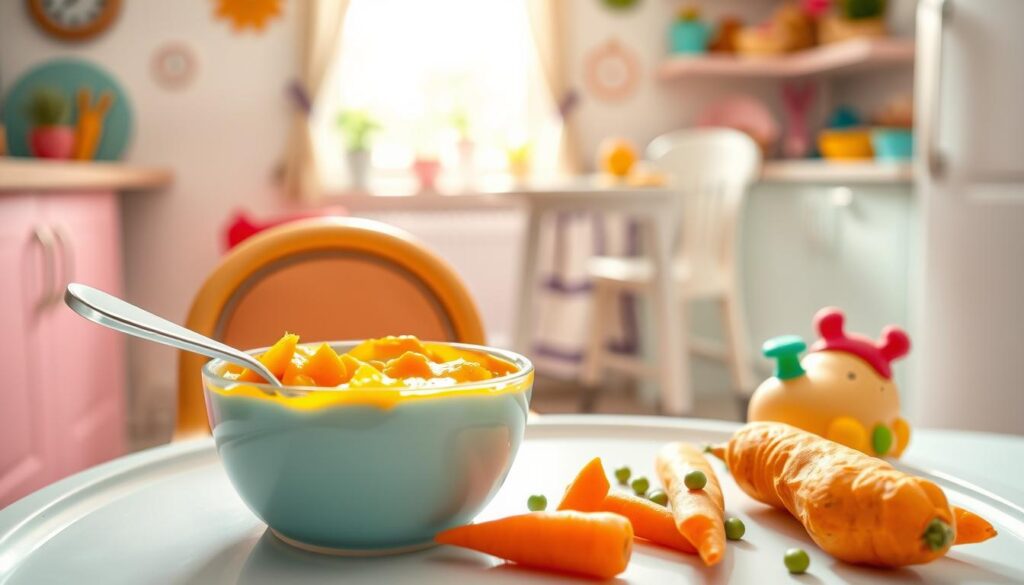
With the right tools and practice, you’ll make tasty, healthy meals for your baby. Always check with your pediatrician before introducing baby to solid foods. This ensures you’re doing what’s best for your baby’s growth.
| Equipment | Description |
|---|---|
| Baby food maker | A device used to prepare and puree baby food |
| Spoons | Used to feed baby and can be made of plastic, metal, or silicone |
| Storage containers | Used to store baby food and can be made of glass, plastic, or stainless steel |
Best First Foods for Your Baby’s Journey
When you start your baby on solid foods, pick the best options. These should be nutritious and safe from allergies or choking. Always follow the guidelines for feeding your infant to make the transition easy.
Start with single-ingredient purees. This lets you watch for any signs of allergy or intolerance. Good starter foods include fruits like avocado, mango, and peaches. Also, try vegetables like sweet potatoes, carrots, and green beans.
Proteins like chicken, turkey, and fish are great too. Introduce these foods one at a time. Start with small amounts and keep the order the same to watch for any bad reactions.
Single-Ingredient Purees
- Avocado puree: rich in healthy fats and fiber
- Sweet potato puree: high in vitamins A and C, and fiber
- Chicken puree: excellent source of protein and iron
Nutritious Starter Options
You can also add whole grain cereals, legumes, and dairy products to your baby’s diet. Always check with your pediatrician before trying new foods.
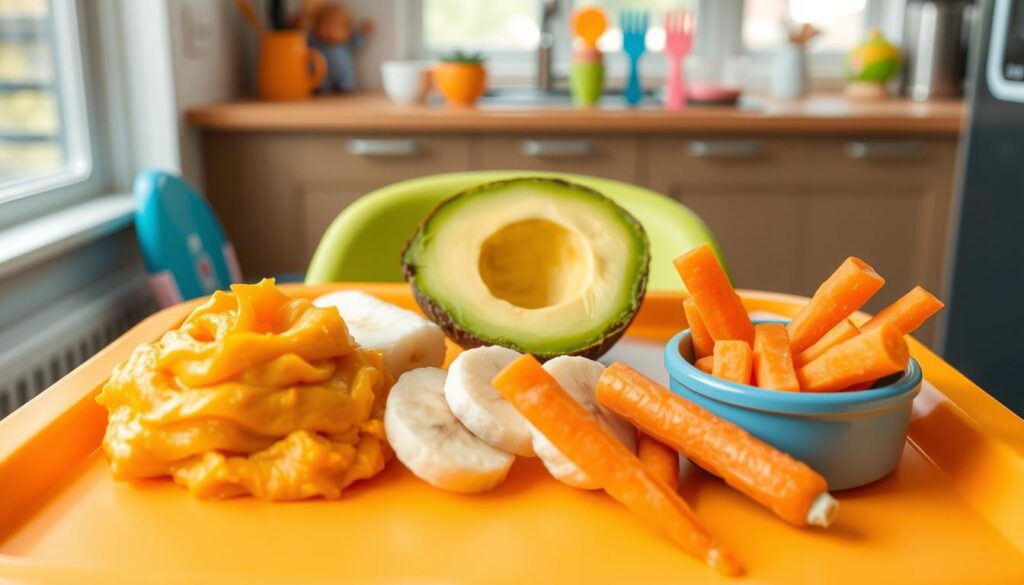
Foods to Avoid in the First Year
Stay away from foods that can cause allergies or choking in the first year. Avoid peanuts, tree nuts, and shellfish. Also, skip popcorn, nuts, and seeds. By choosing the right foods, you can help your baby have a healthy start with solids.
Introducing Solid Foods to Your Baby: Step-by-Step Guide
When introducing solid foods to your baby, start with small amounts. Then, slowly add more food types. This method helps avoid digestive issues and allergic reactions. Begin with simple foods like rice cereal or mashed banana. Then, introduce new foods every few days.
Preparing and storing food safely is important. Always wash your hands before handling food. Store leftovers in airtight containers in the fridge. Here are some tips for how to start solids:
- Start with a single-ingredient puree to monitor for allergic reactions
- Gradually increase the quantity and variety of foods
- Store leftovers safely to prevent spoilage and foodborne illness
Be patient and flexible as you start introducing solid foods to your baby. Every baby is unique. Follow these steps and tips for a smooth transition to solid foods.
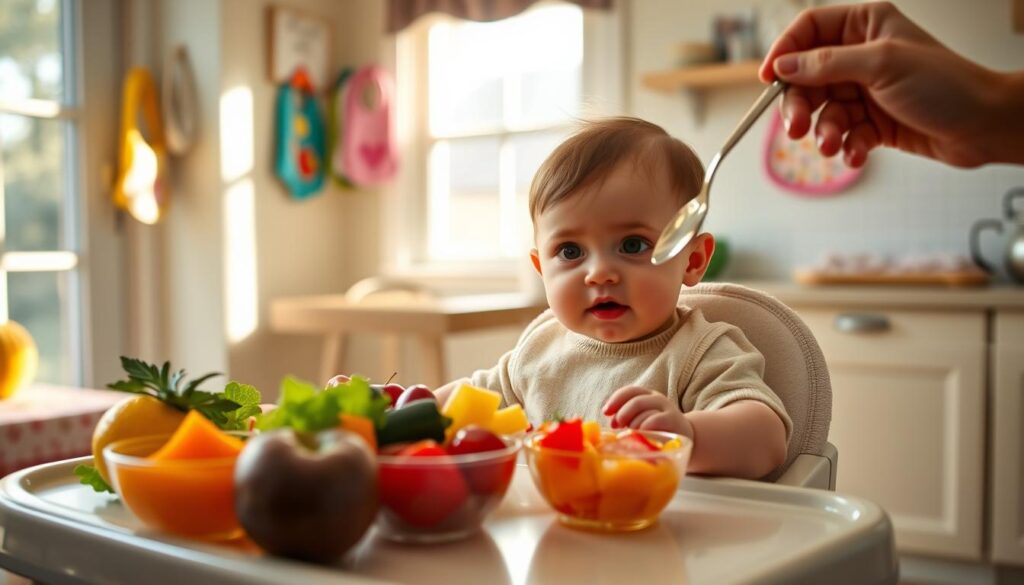
Safety Guidelines and Choking Prevention
When introducing solid foods to your baby, it’s key to follow safe feeding guidelines. Choking prevention is a major concern. Be aware of hazards like nuts, popcorn, and hard candies, and avoid them.
The American Academy of Pediatrics suggests starting solid foods at 6 months. Start with single-ingredient purees and gradually add more textures and foods. The right time to start solid foods varies based on your baby’s development.
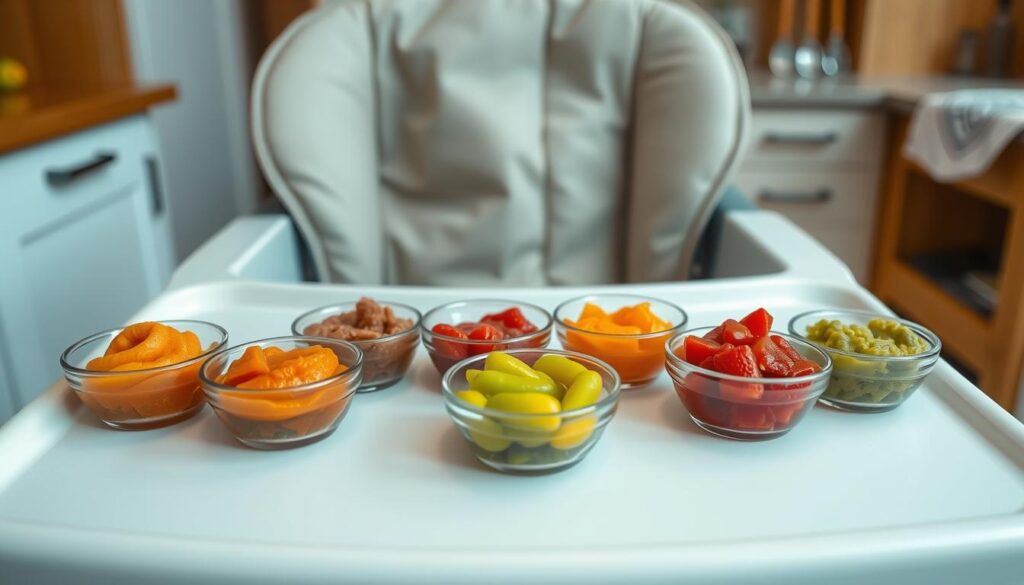
To lower choking risks, prepare foods safely. Cut them into small pieces and remove seeds and pits. Here are more tips:
- Always watch your baby while they eat
- Let them try to feed themselves, but step in if needed
- Stay away from foods that are likely to cause choking, like hot dogs or grapes
By following these guidelines, you can make introducing solid foods safe and fun for your baby. Always put your baby’s safety first and seek advice from your pediatrician if you’re unsure.
| Food | Choking Hazard | Preparation Technique |
|---|---|---|
| Nuts | High | Avoid giving whole nuts to babies under 3 years old |
| Popcorn | High | Avoid giving popcorn to babies under 3 years old |
| Hard Candies | High | Avoid giving hard candies to babies under 3 years old |
Creating a Feeding Schedule That Works
When introducing solid foods to your baby, setting up a feeding schedule is key. This schedule helps figure out how often and how much to feed. It makes the baby food introduction easier.
A good schedule also spots issues like food allergies early. As you begin starting solids for baby, stay flexible. Adapt to your baby’s changing needs and schedules.
Here are some tips for a feeding schedule:
- Start with a routine and adjust as needed
- Watch for signs of fullness or hunger
- Be mindful of meal times and snack times
Every baby is unique, and what works for one might not for another. Being flexible and paying attention to your baby’s needs helps create a schedule that fits your family.
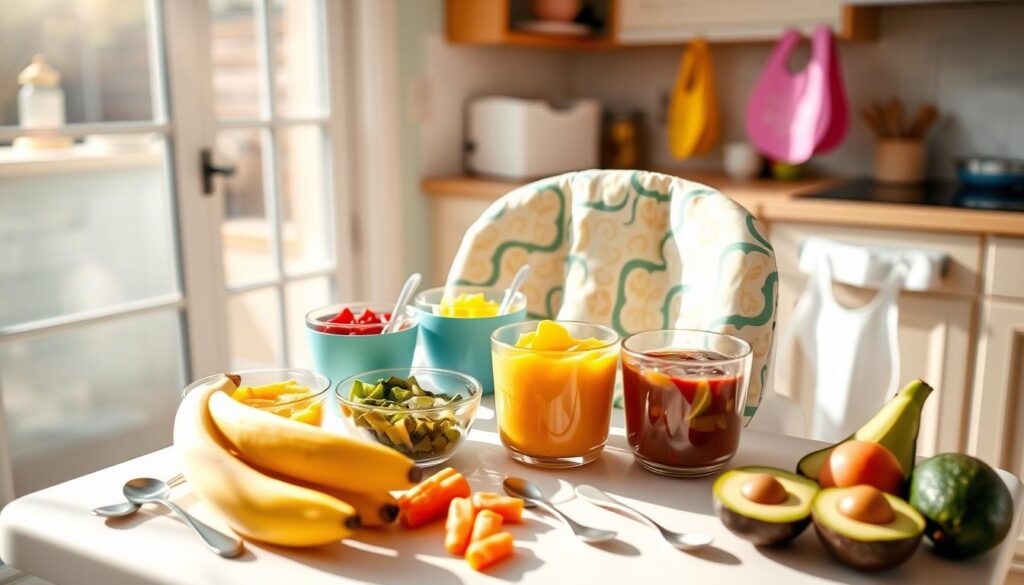
As you navigate the world of solid foods, keep in mind that it’s a journey, and it’s okay to take it one step at a time. With patience, love, and a well-planned schedule, you and your baby will thrive.
Managing Common Challenges and Concerns
Starting your baby on solid foods can be a journey filled with challenges. Food rejection is a common issue that can be tough for parents. Begin with small amounts of purees and slowly increase them. This helps prevent overwhelming your baby’s taste buds.
It’s also important to watch for allergic reactions. If your baby shows signs like rash, itching, or swelling, get medical help right away. Introducing purees to your baby needs patience and careful watching. Here are some tips to help you:
- Start with single-ingredient purees to identify possible allergens
- Introduce new foods one at a time, waiting 2-3 days before trying another
- Watch your baby’s reaction to each new food, looking for signs of allergy or intolerance
Some babies may not like certain textures, like lumps or smooth purees. To help, mix different textures or slowly introduce new ones. By following these tips and paying attention to your baby’s needs, you can help them enjoy solid foods.
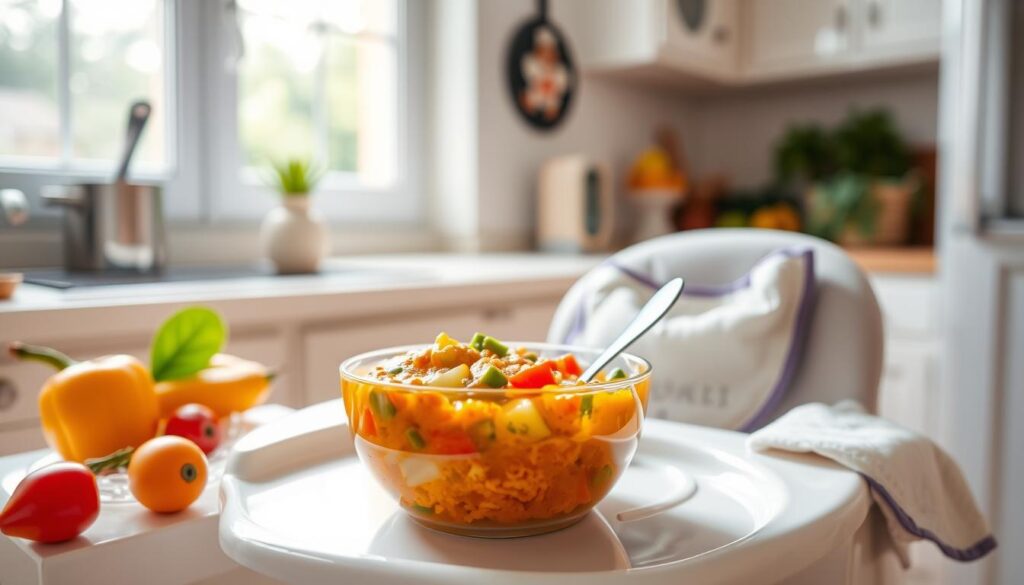
Every baby is unique, and what works for one might not work for another. If you’re worried about your baby’s reaction to solid foods or have questions, talk to your pediatrician. They can give you advice on the best first foods for your baby.
| Common Challenges | Solutions |
|---|---|
| Food Rejection | Start with small amounts, gradually increase quantity |
| Allergic Reactions | Seek medical attention, introduce new foods one at a time |
| Texture Sensitivities | Mix different textures, gradually introduce new textures |
Transitioning from Purees to Finger Foods
As you introduce solid foods to your baby, following infant feeding guidelines is key. Around 6 months, babies show they’re ready for new textures. They might pick up small things and try to eat them.
The American Academy of Pediatrics says finger foods are important for babies. Start with soft foods like mashed bananas or avocados. Then, move to more textured foods as your baby gets used to eating with their hands.
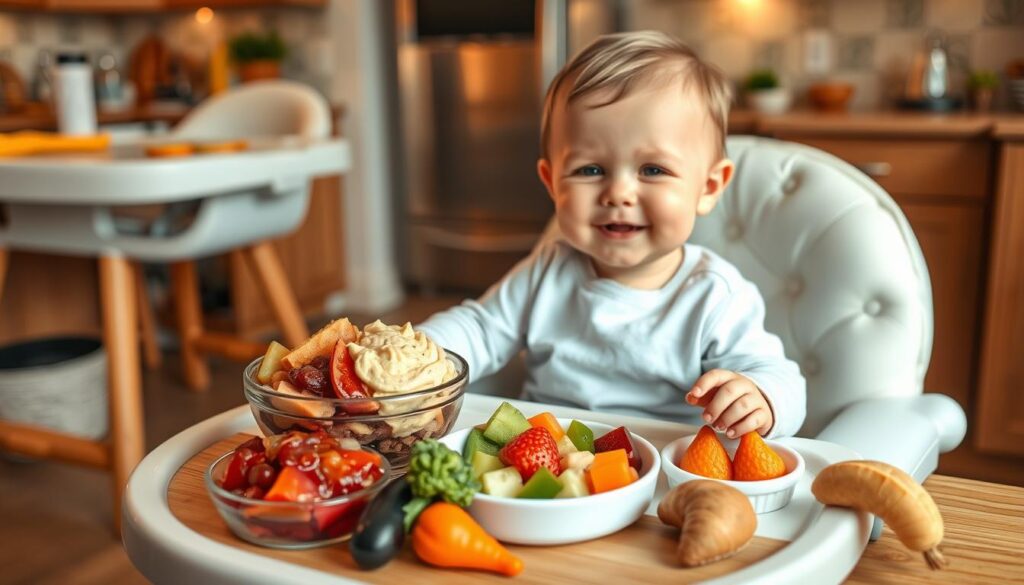
- Steamed vegetables, such as carrots or zucchini
- Cooked and diced chicken or turkey
- Soft fruits, like peaches or pears
Always watch your baby while they eat and never leave them alone with food. By following these steps, you help your baby develop good eating habits for life.
| Finger Food | Texture | Age Recommendation |
|---|---|---|
| Mashed bananas | Soft | 6 months |
| Steamed vegetables | Soft to medium | 8 months |
| Cooked and diced chicken | Medium | 9 months |
Conclusion: Nurturing Healthy Eating Habits for Life
Starting your baby on solid foods is more than just feeding them. It’s about building a strong foundation for a lifetime of healthy eating. By choosing the right baby food and introducing it slowly, you’re helping your baby succeed.
Healthy eating habits from the start have many benefits. Kids who eat a variety of nutritious foods are less likely to face obesity or chronic diseases. They also learn to enjoy a wide range of natural flavors.
Keep being patient, flexible, and in tune with your baby’s needs. Your guidance will help your baby develop a positive view of food. Enjoy the journey, celebrate the small wins, and cherish every moment. Introducing solid foods is a special time that sets the stage for a healthy future.
